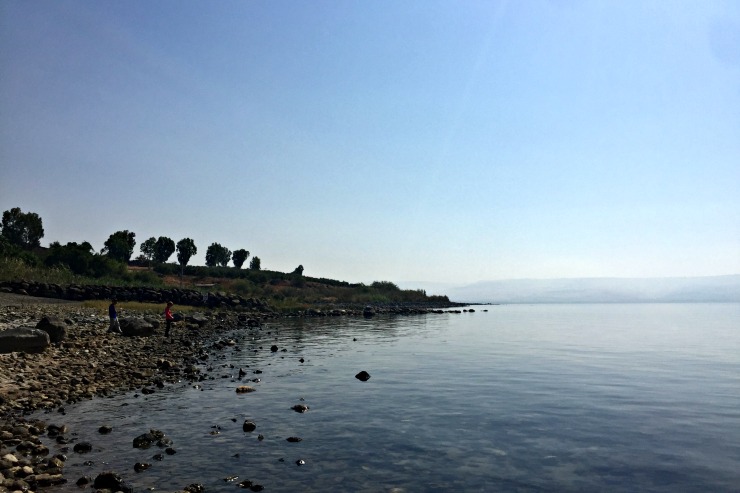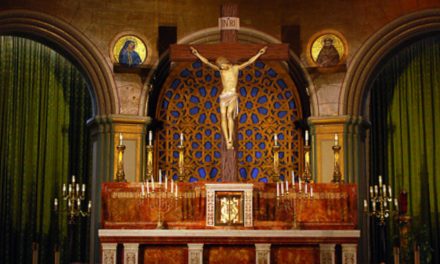Without realizing it, we have begun to think of Jesus as character or idea instead of an individual. Perhaps it is more comfortable, more convenient, less radical this way.
“From Mount Hor the children of Israel set out on the Red Sea road, to bypass the land of Edom…” began the first reading at Mass earlier day this week. Years ago, perhaps I would have pictured a brightly-colored cartoon derived from a picture Bible of my youth, or maybe an aging Charlton Heston would walk across my mental image when I heard those words. That morning, however, I immediately saw the sun setting between rough hills, burning the orange-hued rocks into browns, their irregular and jagged edges casting shadows into the valley.
Mount Hor. The white tomb of Aaron so distant it was easily missed amongst the splendor of the setting sun; the quietness that comes with the dusk settling around us as we stood and looked out over the breath-stealing sight. Later that night, we would drink wine while listening to six Jordanian young men sing poetry around an oud and play an intense game of ping-pong, our ball sailing in the night sky and coming close to landing in very rocky valley where the Israelites pitched their tents.
Now, when I hear the words ‘Mount Hor,’ I think of our Jordanian guide David, who so proudly pointed out hills and valleys and landmarks, followed seamlessly with chapter and verse, just as if he was quoting Scripture. “Zered Valley… Numbers 21:12.” The Israelites and their journey is no longer the stuff of picture books or movies.
Rocks. Land. History. Memories–not of storybooks, but of lived experiences.
If you tell someone the story of the Battle of Gettysburg, they can draw a mental picture of the battle. If you show them the movie, filmed on location, they’ll begin to grasp the highs and lows, the feel of the advances and the drama of the landscape. But nothing compares to walking through Devil’s Den or standing at the infamous copse of trees that marked the target for Pickett’s Charge. After that, the history books read differently. Because you have walked history. It’s no longer the stuff of mental images and stories. It is yours.
The temptation for us as we enter Holy Week and hear the familiar stories is that they become too familiar. The thrill of Palm Sunday, the highs and lows of Holy Thursday, the darkness of Good Friday, the dramatic pause of Holy Saturday. We know the stories. We have the mental images, perhaps even vivid ones from The Passion of the Christ or a particularly moving painting. But perhaps the danger is that we have forgotten it is all real. Without realizing it, we have begun to think of Jesus as character or idea instead of an individual. Perhaps it is more comfortable, more convenient, less radical this way.
I had an acquaintance who dismissed going on pilgrimage to the Holy Land because she liked her own ideas of what things looked like. It reminded me of when die-hard Tolkien fans resisted going to see Lord of the Rings for fear of replacing their mental pictures of Frodo and Galadriel. The latter I can sympathize with far more than the former. The events of Scripture are not just a picture in your head. They’re real, historical moments. They are people that existed at a certain time and events that occurred in very particular places.
This is central to our belief as Christians. The eternal God entered history. He took on human flesh, with specific DNA, and he walked a certain way on certain rocks and in certain towns. The stories of the preparation for the Incarnation through the Chosen People are not fables, nor are the Annunciation and birth of our Lord poetic imaginings. The Resurrection wasn’t simply a faith experience of the Apostles, a parable, or a theological explanation. It was a real physical Resurrection, and it happened in a real place at a real moment in history. If you don’t believe that, you aren’t a Christian.
I stood on Mount Nebo, where Moses looked out over the Promised Land before dying. And I whispered, “It’s all real.” Then I said it louder. “It’s all real.” Moses. Elijah. Jesus. It all really happened. In time, in space, in history. Before then, I knew that intellectually. But now I had walked, and touched, and seen.
I am not saying you can’t be a good Christian without going on pilgrimage to the Holy Land. There is, however, good reason why people for thousands of years have risked their lives and spent their entire fortunes to go there. Once you walk and breathe in that place, once you pray in the empty tomb, your relationship with Jesus should never be the same. Because He has leapt off the pages of Scripture, He has reached out from the monstrance, He has reminded you: I am real.
As we enter Holy Week, may we strive to come closer to the real, historical Jesus Christ. Not to dissect the Scriptures with criticism, but to grow closer to a God that loved us so much, He entered time and space. Are we ready to love the God who suffered real pain for us? Are ready to believe in a God that stopped breathing?
He died at a real moment in history. And He conquered death at a real, historical moment. Do we really believe that? Are we ready to face the alteration of life that comes with that?














